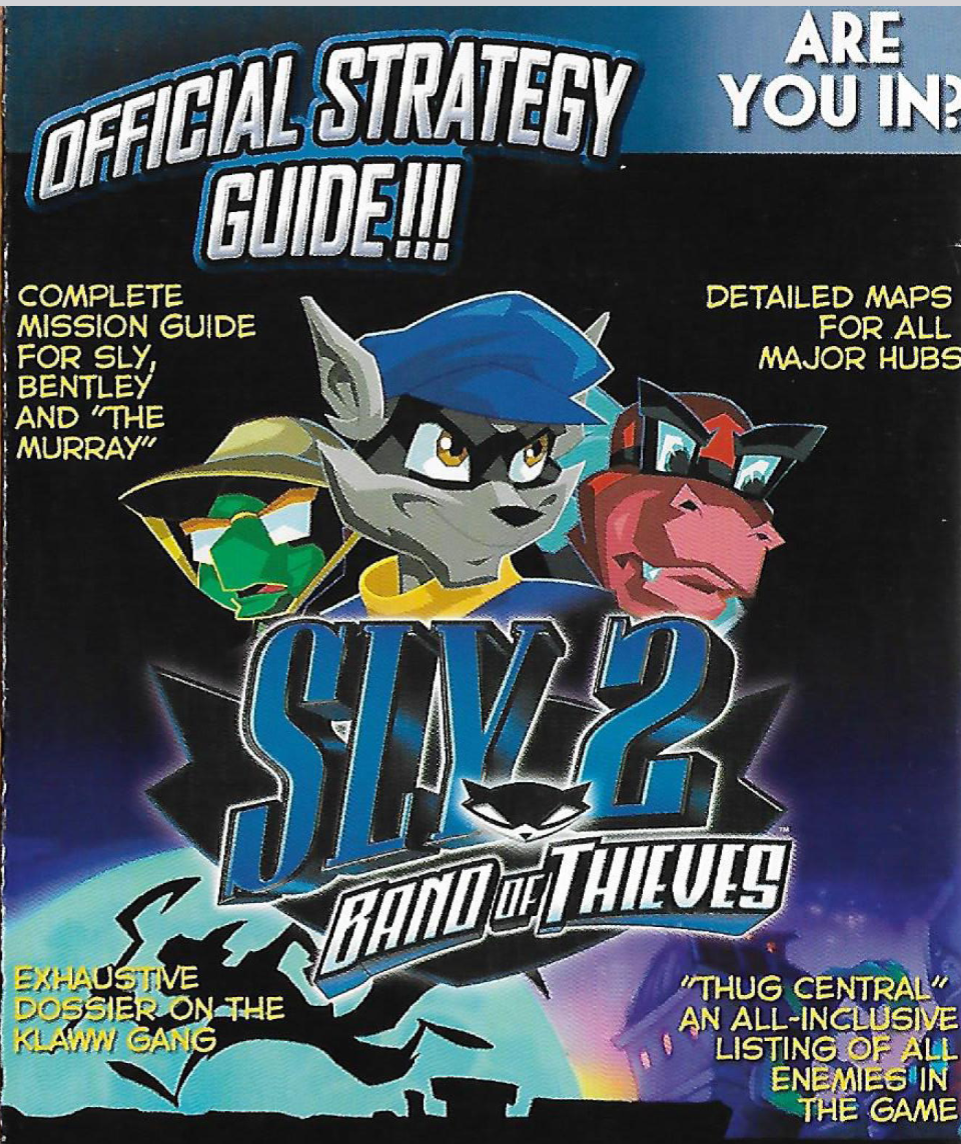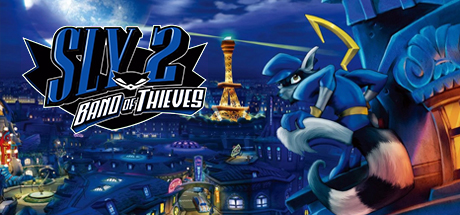I know I’m 20 years late to this one. I don’t promise timely takes. I get to games when I can, which is often way after they come out. It’s part of the reason I’m so averse to spoilers.
Sly 2 is, according to Wikipedia, considered to be the best of the Sly Cooper trilogy. I have not played Sly 3, but I have played the first two , and I can confidently say that I both understand why this claim was made, and that I disagree with it thoroughly.
I’ll go a step further: this beloved game (consistently ranks among the best 3D platformers and among the best PS2 games ever) isn’t a great game. Not in 2024. And it’s certainly worse than its predecessor.
tl;dr: It’s nice to play as Murray and Bentley and see them leave the van. But it’s not nice to have to cross town as Bentley avoiding guards that spawn endlessly just to stop you from getting to where the actual mission is!
First, what is Sly Cooper?
What is Sly Cooper
Sly Cooper is a game about a raccoon. It’s one of the PlayStation 2’s early cartoon mascots, along with Spyro the Dragon, Jak and Deter, Crash Bandicoot, and Ratchet and Clank. He’s a Daniel Ocean type, a charming (racoon) thief who has a personal stake in the places he robs. Sly is an orphan with a tragic backstory who commits crimes for the greater good. He sees himself as a Robin Hood type, stealing from other thieves, and doing so with principals and panache.
In the first game, the stakes are incredibly personal. Sly comes from a long line of racoon thieves (thieves who are also raccoons, to be clear). Years ago, a band of villains teamed up, killed Sly’s parents, and stole his father’s book, the Thievious Raccoonus. This tome collected together various secret techniques about how to be a better thief. Years later, Sly is an adult, and the villains have split up the book amongst themselves, and started their own criminal empires.
This motivation is brilliant. It gets you invested in the game, and it serves as a levelling up technique: when you finish a level, you’ve successfully stolen back a page of the book, and can learn a new technique for use in the next level. It also makes it clear that while you’re not exactly a /good guy/, the people you’re taking down are much worse.
The first game also establishes relationships: your two best friends (lifelong pals from the orphanage), Bentley (a nerdy, genius turtle with a love of explosives), and Murray, a big strong worrywart who loves a good meal almost as much as he loves his friends.
 Bentley the turtle, Sly the Raccoon, and Murray the Hippo.
Bentley the turtle, Sly the Raccoon, and Murray the Hippo.
So now that you know the backstory, what’s changed in the sequel?
What’s changed
You can’t just release the same game again. You’ve got to make improvements, or at least changes. Some franchises take bigger risks in their sequels, while others stick closely to a winning formula. So what does Sly 2 change from the first game?
The Scope
Sly 2: Band of Thieves is listed on How Long to Beat at 16 hours, over twice as long as the 7-hour Sly Cooper and the Thievious Raccoonus. And that’s great — bigger is always better, right? Not so. This game has more levels (8) than the original’s 5. But each of those levels are also longer, padded out with new side-quests. And a lot of these side quests are tedious, and feel bloated.
In what might be the mantra of our age, curated, hand-crafted content is good. Content for the sake of content isn’t. There are some really neat objectives! They get less neat when you’re asked to do them multiple times.
Every lock in the game has between 3 and 8 keys that you need to pickpocket off of patrolling guards. Did I mention that each guard needs to be pickpocketed 3 times before they give up one key? There are always 4 beacons to activate or 3 pillars to destroy. It’s never a one-and-done with this game.
I get not wanting to create a bespoke mechanic and then never use it, but that’s not the case! There are dozens of Bentley hacking mini games throughout the levels, but they still pad out each one. While rigging the Canadian Olympic Lumberjack Games, Bentley has to track down Murray, be thrown onto a ship, and then go through a hacking mini game… three times. The whole game is filled with moments like this, where you do something neat, and then repeat it until it stops being fun.
There’s a wide variety of mini games: you pilot an RC helicopter, hack computers, dodge, traps, pickpocket guards, chuck heavy machinery at alarms (most alarms need to be hit 2-3 times, and there’s never fewer than 4 alarms for you to track down and find).
But the mini games themselves are drawn out. One of the many piloting missions has you shoot down 20(!) plans without getting destroyed. Why not have 10 planes that all hit twice as hard?
Early on, there’s a sort of slow-paced dance, where the player is prompted with a Simon Says sequence of three buttons to push. These sequences are slow and long. Seriously, here’s a clip of one:
You watch as these buttons are revealed, one at a time, and then you get a leisurely window to press them, one at a time. This goes on for 3 minutes! This isn’t fast-paced, challenging, or fun! Why was this sequence left in? Is it possible to lose this? I don’t want to try, for the risk of having to do more of it!
I’m not opposed to a little rhythm game. The first game had a singing hippo boss-fight that resembled Guitar Hero. I was bad at it, it took me a lot of tries to do it. But I remember it! If too many people got stuck there, remove it, don’t just lower the difficulty to the point of being unfailable.
The Stealth
Most of the first game was pure stealth, with some platforming mixed in. If you got spotted, you lost a life and had to start the level over, which meant you had to be crafty and plan things carefully.
In the sequel, they added hit points, and lots of enemies. So if an enemy sees you, it meant a fight. This takes away the immediate consequences of stealth, you have a chance to fight on and not fail the level. It also makes it tedious, as one enemy will call in more, and soon you’re surrounded by enemies.
The first game had a system of small levels, each with various clues (bottles) hidden around this. The sequel moved to a hub-and-spoke design, where you have massive open-world levels with bottles strewn around them. This means the bottles could be anywhere, whereas the first game you had smaller environments with clever hiding places.
It also means that you have to repeatedly cross these big, open worlds in order to get to the next part of the game. And these big open worlds are filled with guards who attack you on sight and summon more guards. This is particularly frustrating as Bentley, who can only attack with a slow crossbow.
Things age poorly
Geometry Wars is great. It’s a twin-stick shooter where you zoom around a box trying not to get blown up by shapes. Over time, particle effects fill the screen, and enemies gain newer, more creative ways to bring you down.
Bentley’s hacking game is no geometry wars. It’s a twin-stick shooter, with endlessly-spawning enemies chasing you, but it’s much slower than geometry wars. Each mission ends with you having to shoot dozens of tiny red dots that track your movements. Each dot needs to be shot by your tiny little pellets multiple times before it’s destroyed. Meanwhile, slow-moving enemies circle around you, so you have to take breaks from pointing your joystick at the too-many dots to clear out the enemies for a minute before they regroup.
This is a lot of Bentley’s missions. Some of the non-hacking ones are great! There’s a boss-fight and a mission where he has to pull levers to activate floor traps to stop enemies who are trying to rush towards him. Naturally, the mission has you do this for 3 minutes in 4 separate locations, but those missions are so much more fun (and difficult!) than the tedious hacking minigame. And what does Bentley do most often? It’s the hacking!
The plot doesn’t make sense
1. At the end of Sly 1, you destroy a big evil mechanical bird named clockwork. At the start of Sly 2, that bird has been chopped into bits and distributed across the globe. Each of those pieces is being vigorously guarded by a different criminal mastermind and their retinues.
You recognize that these artifacts would be disastrous if someone combined all of them, so you proceed to sneak into every single criminal empire and steal them. Once they’re in one place, guarded by 3 dweebs with no minions, someone inevitably steals them.
Then you have to stop them with a big set piece boss battle.
So okay, this was entirely preventable. It gets worse.
2. The new Clockwork bird has a plan that involves using a giant battery to hypnotize all of Paris.
Except it’s clearly established (in the scene before this plan is revealed) that your gang personally shorted out, drained the power from, and then HOLLOWED OUT the battery needed for this plan. There was never any threat, but your team acts as if there is. Why??
3. The first betrayal (of many) in this game is when Neyla turns on Carmelita. She gets witnesses at a nightclub to testify that Sly was dancing with Carmelita, ignoring the fact that she herself was dancing with him mere minutes earlier! This is ultimately a nit, but it’s one more thing on the stack, you know?
Enemy variety
There are approximately 4 different enemies in this game. In each level they are re-skinned to match the scenery, but otherwise function almost identically. It gets old. Especially the guards who shoot rockets at you slightly faster than you can stand up.
It’s not all bad
There are things I like about Sly 2! You can play as Murray, Jean Bison is an incredible villain, rigging an Olympic Games is a wonderful twist on the heist genre.
The blimp level feels like the steampunk successor to the opening boiler rooms of the first game, and uses the terrain cleverly. At the very end of the level, they give you a satisfying super jump power… that they strip away at the end of one (1) mission, despite there being only a few more minutes of gameplay left. They could have let you continue to be jumpy McGee!
It’s great that money is more meaningful than in the first game, and the pickpocket mechanic is quite cool.
Neyla is established as an excellent villain, and her turn on Arpeggio was masterfully done!
But these gems are lost among the bloat. I gave up trying to find all of the bottles after a few stages because the levels were simply too big.
The first game was small, focused, and charming. The sequel expanded on it in some obvious ways (adding more levels, and more playable characters), but would have been more charming if it had respected players’ time by cutting down the repetitive tasks.
